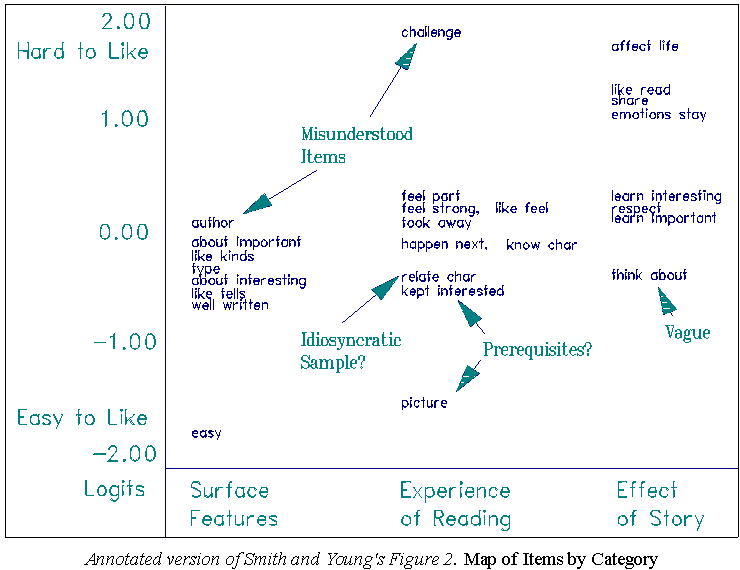
Laying out items by difficulty and classification in an item map aids interpretation and inquiry. Smith and Young (1995) present an item map based on the responses of 118 children to 26 items relating to how they liked a story. The clear superiority of the map over conventional tabular displays is evident.
Excerpt from Smith & Young's Table 1. A List of Items and Summary Statistics Items Rating: Mean S.D. 1. I like this type of story 1.80 0.74 2. I like stories by this author 1.62 0.58 3. This story was easy to read 2.39 0.60 . 26. Now that I've read this story.. 1.09 0.77
In their Table 1 (excerpted here) are presented the means and standard deviations of the raw ratings to the 26 items. The items were rated on a 4 category scale from strongly disagree to strongly agree. Nothing jumps out at the reader from the undifferentiated list of 26 numbers in two columns.
Excerpt for Smith & Young's Table 3. A List of Items and Logit Values Items Logit 1. I like this (type) of story -.44 2. I like stories by this (author) .01 3. This story was (easy) to read -1.87
Their Table 3 (also excerpted here) advances to the use of logits and classifies the items into three types: "Relating to surface features of a story", "Relating to experience of reading", and "Relating to effect of a story". It is immediately obvious that the classification also stratifies the items by difficulty. The paper then uses the logit values and classification to draw the map shown here.
The general advance of the construct is clear: surface features => experience of reading => effect. But there are exceptions. Why is "challenge" so hard and "picture" so easy? The text of the paper provides explanations, which are noted on the map. Not all exceptions to the underlying pattern have simple explanations, e.g., this sample's unexpectedly high agreement with "I could really relate to the characters." But now both confirmations of and challenges to the theory of reading underlying the item classification are manifest. The item map communicates the findings of the paper concisely and powerfully in a way that no table of numbers could ever do.

Smith M.W., Young J.W. (1995) Assessing secondary students' liking of short stories. Journal of Educational Research 89(1) 14-22. September/October.
Item map interpretation. Smith MW, Young JW. … Rasch Measurement Transactions, 1995, 9:3 p.446
| Forum | Rasch Measurement Forum to discuss any Rasch-related topic |
Go to Top of Page
Go to index of all Rasch Measurement Transactions
AERA members: Join the Rasch Measurement SIG and receive the printed version of RMT
Some back issues of RMT are available as bound volumes
Subscribe to Journal of Applied Measurement
Go to Institute for Objective Measurement Home Page. The Rasch Measurement SIG (AERA) thanks the Institute for Objective Measurement for inviting the publication of Rasch Measurement Transactions on the Institute's website, www.rasch.org.
| Coming Rasch-related Events | |
|---|---|
| Jan. 16 - Feb. 13, 2025, Fri.-Fri. | On-line workshop: Rasch Measurement - Core Topics (E. Smith, Winsteps), www.statistics.com |
| Apr. 8 - Apr. 11, 2026, Wed.-Sat. | National Council for Measurement in Education - Los Angeles, CA, ncme.org/events/2026-annual-meeting |
| Apr. 8 - Apr. 12, 2026, Wed.-Sun. | American Educational Research Association - Los Angeles, CA, www.aera.net/AERA2026 |
| May. 15 - June 12, 2026, Fri.-Fri. | On-line workshop: Rasch Measurement - Core Topics (E. Smith, Winsteps), www.statistics.com |
| June 19 - July 25, 2026, Fri.-Sat. | On-line workshop: Rasch Measurement - Further Topics (E. Smith, Winsteps), www.statistics.com |
The URL of this page is www.rasch.org/rmt/rmt93f.htm
Website: www.rasch.org/rmt/contents.htm